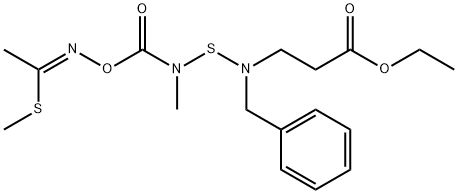Alanycarb is a broad spectrum oxime carbamate insecticide with
both contact and oral toxicity to a wide variety of insect pests, especially
Lepidoptera, Coleoptera, Hemiptera and Thysanoptera, in/on grapes,
pome fruits, tobacco and vegetables. Alanycarb can be applied as foliar,
soil or seed treatments.
Alanycarb may be used as an analytical reference standard for the determination of the analyte in:
- Olive oil samples by fast liquid chromatography-electrospray time-of-flight mass spectrometry (LC-TOFMS).
- Vegetables and fruit juices by LC coupled to tandem mass spectrometry (MS/MS).
Alanycarb is a oxime carbamate inseciticide with acetylcholinesterase inhibitor activity.
ChEBI: Alanycarb is a carbamate ester and an ethyl ester. It has a role as a carbamate insecticide, an EC 3.1.1.7 (acetylcholinesterase) inhibitor, an agrochemical and a nematicide.
Alanycarb is classified under the oxime carbamate group of insecticides. Its mode of action involves the inhibition of cholinesterase enzyme.
Alanycarb is a pro-insecticide which transforms either chemically or biologically
into the active substance methomyl. Alanycarb metabolism in
soil, plants and animals follows a common pathway that is consistent
with methomyl. The primary metabolic pathway involves the initial
cleavage of the N-S bond of alanycarb to yield methomyl and ethyl
N-benzyl-β-alaninate. Methomyl is further metabolised to S-methyl-N-hydroxythioacetimidate
and ultimately to acetonitrile, acetic acid and
carbon dioxide (Scheme 1). See also the methomyl entry.
Alanycarb (1) was stable to hydrolytic degradation in neutral and weakly
basic solutions (pH 7 and 9) at 30 °C with DT50 of 49 hours and 130 hours,
respectively. It degraded rapidly (DT50 0.5 hours) in acidic solution (pH 5)
at 20 °C (Yagi and Kawata, 1992). In acidic buffer solution (pH 4.0), the
major hydrolytic degradation product was methomyl (2). The disulfide
derivative (3) of alanycarb was observed as a minor product. In pH 7
and 9 solutions, hydrolysis of methomyl [S-methyl-N-hydroxythioacetimidate
(4)] occurred and polar unknown products were found as major
degradation products (Kawata, 1994).
Alanycarb degraded rapidly under xenon lamp irradiation (light
intensity: 280-300 μEm-2 s-1) in distilled water with a DT50 of 9.3 hours
(Yagi and Kawata, 1993).
